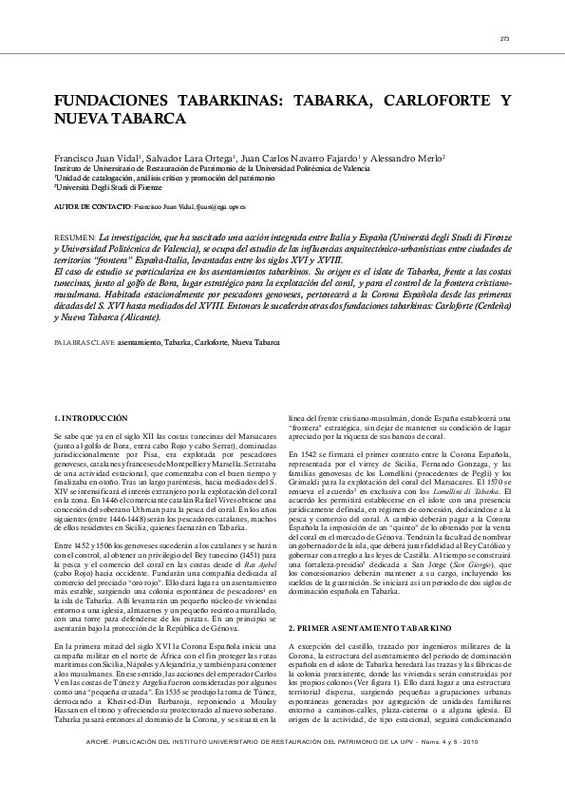JavaScript is disabled for your browser. Some features of this site may not work without it.
Buscar en RiuNet
Listar
Mi cuenta
Estadísticas
Ayuda RiuNet
Admin. UPV
Fundaciones Tabarkinas: Tabarka, Carloforte y Nueva Tabarca
Mostrar el registro sencillo del ítem
Ficheros en el ítem
| dc.contributor.author | Juan Vidal, Francisco
|
es_ES |
| dc.contributor.author | Lara Ortega, Salvador
|
es_ES |
| dc.contributor.author | Navarro Fajardo, Juan Carlos
|
es_ES |
| dc.contributor.author | Merlo, Alessandro
|
es_ES |
| dc.date.accessioned | 2013-07-12T12:02:19Z | |
| dc.date.available | 2013-07-12T12:02:19Z | |
| dc.date.issued | 2010 | |
| dc.identifier.issn | 1887-3960 | |
| dc.identifier.uri | http://hdl.handle.net/10251/31102 | |
| dc.description.abstract | La investigación, que ha suscitado una acción integrada entre Italia y España (Universtá degli Studi di Firenze y Universidad Politécnica de Valencia), se ocupa del estudio de las influencias arquitectónico-urbanísticas entre ciudades de territorios ¿frontera¿ España-Italia, levantadas entre los siglos XVI y XVIII. El caso de estudio se particulariza en los asentamientos tabarkinos. Su origen es el islote de Tabarka, frente a las costas tunecinas, junto al golfo de Bora, lugar estratégico para la explotación del coral, y para el control de la frontera cristianomusulmana. Habitada estacionalmente por pescadores genoveses, pertenecerá a la Corona Española desde las primeras décadas del S. XVI hasta mediados del XVIII. Entonces le sucederán otras dos fundaciones tabarkinas: Carloforte (Cerdeña) y Nueva Tabarca (Alicante). | es_ES |
| dc.description.abstract | The research, which has led to integrated action by Italy and Spain (Universtá degli Studi di Firenze and Universidad Politécnica de Valencia), is concerned with the study of architectural-urban planning influences between Spanish-Italian ¿frontier¿ towns and cities, built from the 16th to 18th centuries. The case being studied is specifically concerned with Tabarka settlements. These are found on the islet of Tabarka, opposite the coast of Tunis, beside the gulf of Bora, a strategic location for the coral business and for control of the Christian- Moslem frontier. Seasonally inhabited by Genoese fishermen, it belonged to the Spanish crown from the first decades of the 16th century until the mid-18th century. This would then be succeeded by a further two Tabarka foundations: Carloforte (Sardinia) and Nueva Tabarca (Alicante). | es_ES |
| dc.format.extent | 6 | es_ES |
| dc.language | Español | es_ES |
| dc.publisher | Instituto Universitario de Restauración del Patrimonio de la UPV | es_ES |
| dc.relation.ispartof | Arché | es_ES |
| dc.rights | Reserva de todos los derechos | es_ES |
| dc.subject | Settlement | es_ES |
| dc.subject | Tabarka | es_ES |
| dc.subject | Carloforte | es_ES |
| dc.subject | Nueva Tabarca | es_ES |
| dc.subject | Asentamiento | es_ES |
| dc.subject.classification | CONSERVACION Y RESTAURACION DE BIENES CULTURALES (UPV) | es_ES |
| dc.title | Fundaciones Tabarkinas: Tabarka, Carloforte y Nueva Tabarca | es_ES |
| dc.title.alternative | Tabarkina foundations: Tabarka, Carloforte and Nueva Tabarca | es_ES |
| dc.type | Artículo | es_ES |
| dc.rights.accessRights | Abierto | es_ES |
| dc.contributor.affiliation | Universitat Politècnica de València. Instituto Universitario de Restauración del Patrimonio - Institut Universitari de Restauració del Patrimoni | es_ES |
| dc.description.bibliographicCitation | Juan Vidal, F.; Lara Ortega, S.; Navarro Fajardo, JC.; Merlo, A. (2010). Fundaciones Tabarkinas: Tabarka, Carloforte y Nueva Tabarca. Arché. (4-5):273-278. http://hdl.handle.net/10251/31102 | es_ES |
| dc.description.upvformatpinicio | 273 | es_ES |
| dc.description.upvformatpfin | 278 | es_ES |
| dc.description.issue | 4-5 | |
| dc.identifier.eissn | 2445-1150 |






